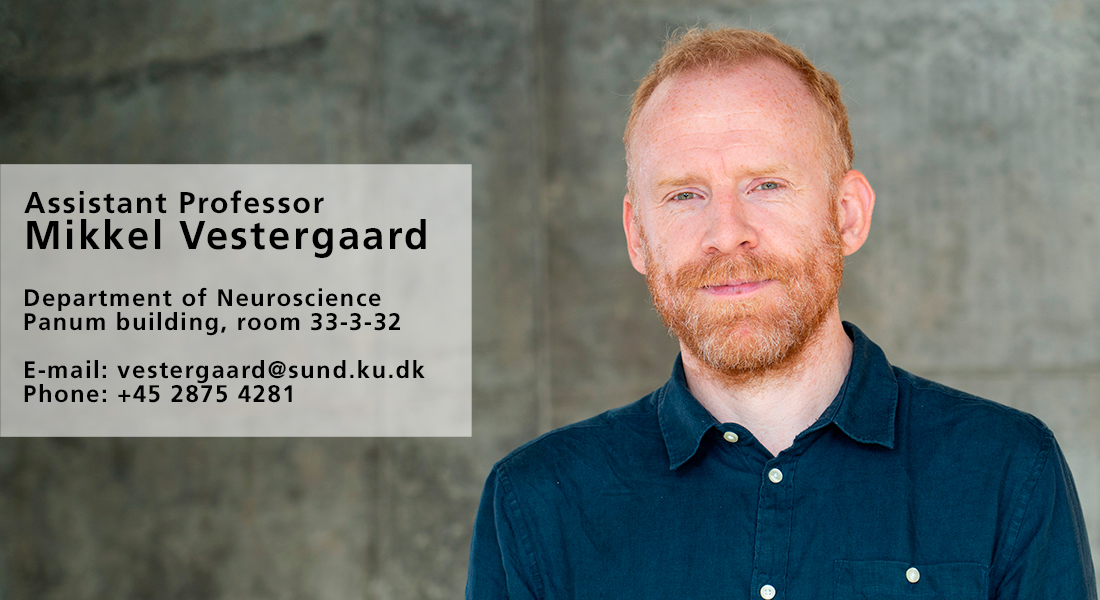If you would like to join us, please get in touch (vestergaard@sund.ku.dk). We welcome people from a diverse set of educational backgrounds with a keen interest in neuroscience.
Vestergaard Lab
In Vestergaard lab we investigate how sensory perceptions are generated in the brain. We are especially interested in the cortical processing of pain and in how the combination of external sensory signals and internal signals from the brain are integrated to form percepts.
Sensory perception is driven by sensory stimuli, but also by internal signals generated in the nervous system. Our main objective is to illuminate the neural mechanisms behind the generation of perception and how different signals contribute and are integrated.
A specific goal for the lab is to understand the cortical processing of pain. The experience of pain is complex with both a sensory and an emotional component and highly influenced by other factors such as attention. It is an open question how the internal dynamics of the brain are integrated with sensory signals to form pain percepts.
To this end, we explore neural processing in insular cortex and its integrative properties. Insular cortex is a highly multi-functional area involved in sensory processing and responsible for body state representations and the associated emotions. It is central for pain perception, as well as for conditions such as eating disorders, anxiety and depression. This makes insular cortex a key area for understanding integration of sensory and internal signals.
We use techniques such as electrophysiology, microscopy, optogenetics, behavioral testing and computational methods to understand neural processing in mice.
-
Vestergaard, M.*, Carta, M.*, Güney, G., & Poulet, J. F. A. (2023). The cellular coding of temperature in the mammalian cortex. Nature, 614 (7949), 725-731.
-
Lindén, H., Petersen, P. C., Vestergaard, M., & Berg, R. W. (2022). Movement is governed by rotational population dynamics in spinal motor networks. Nature, 610 (7932), 526-531.
-
Radosevic, M., Willumsen, A., Petersen, P. C., Lindén, H., Vestergaard, M., and Berg, R. W. (2019). Decoupling of timescales reveals sparse convergent CPG network in the adult spinal cord. Nature Communications. 10:2937.
-
Vestergaard, M., & Berg, R. W. (2015). Divisive gain modulation of motoneurons by inhibition optimizes muscular control. The Journal of neuroscience, 35(8), 3711-23.
-
Petersen, P. C., Vestergaard, M., Jensen, K. H. R., & Berg, R. W. (2014). Premotor spinal network with balanced excitation and inhibition during motor patterns has high resilience to structural division. The Journal of neuroscience, 34(8), 2774-84.
2024-present: Group leader, University of Copenhagen
2016-2024: Postdoc, Poulet Laboratory, Max Delbrück Center, Berlin, Germany
2015-2016: Postdoc, Berg Laboratory, University of Copenhagen
2012-2015: PhD Fellow, Berg Laboratory, University of Copenhagen
- Electrophysiology
- Microscopy
- Optogenetics
- Behavioral testing
- Computational approaches
Lab members
| Name | Title | Job responsibilities | |
|---|---|---|---|
| Search in Name | Search in Title | Search in Job responsibilities | |
| Mikkel Vestergaard | Assistant Professor | Vestergaard Lab |
|

